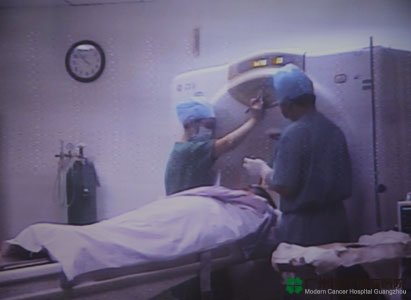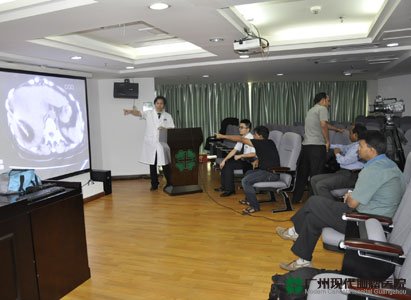
What happen at -165℃?
Up to now, the lowest temperature detected on the earth is -89.6℃ in South pole. In such a low temperature, even steel would be as fragile as ice. Then how about -165℃, the ultra-low temperature which is nearly two times lower than 89.6℃ and what will happen if injecting the air in such low temperature inside tumor?
On 10:00 am. Sep. 22, 2012, a cancer treatment named cryotherapy was performed in the operation room on 9th floor of Modern Cancer Hospital Guangzhou. The whole procedure was simultaneously broadcasted through video transmission equipment in the meeting room on the same floor. The media delegation from Bangladesh watched the treatment to know what minimally invasive treatment of tumor is.
There was going the treatment of cryotherapy, which is to inject the air of -165℃ into the tumor inside patient. What would happen to tumor at this low temperature?
Through video we can see the doctor has finished the sterilization on operative skin of patient. Everyone held breath to wait for the next step. In order to relieve the nervous atmosphere, Dr. Peng introduced cryotherapy to presenting journalists of Bangladesh: cryotherapy is a tumor treatment of whole-process monitor, precise positioning and fast freezing. Through the alternative shift of ultra-low and normal temperature, huge temperature difference is made in a short time inside tumor to freeze tumor and destroy tumor cells completely.
To witness the magical cryotherapy
Soon after anesthesia, through video we can see that, the doctor was setting the point, angle and depth for needle insertion through CT scan. A fine and long stainless steel needle-tube was punctured into target spot of tumor and its angle of insertion was adjusted through the date presented on computer. After all these were fixed, the bushing of cryotherapy was inserted slowly into tumor through the needle tube.
Then the doctor started the cryotherapy and Dr. Peng explained that argon gas will decrease the temperature to -165℃within 10 seconds. Journalists clearly saw the formation of ice ball which gradually had covered the tumor through rapid freezing of argon gas.
When taking photos and videos, journalists also talked to Dr. Peng and one of them asked:” normally operation should be bloody, but why I did not see any bleeding?” Dr. Peng explained that cryotherapy is not a real operation, it actually is a minimally invasive treatment with the advantages of small trauma and small bleeding.
15-20 minutes later, Dr. Peng added that the temperature would increase to 20-40℃rapidly after helium gas is injected. After that would be another cycle of freezing. So in this procedure, there are total 2 cycles of freezing and 1 cycle of heating.
Through the whole treatment, the patient was easy and relaxed without any complaint. His physical signs like blood pressure, pulse and breath were normal. Every journalist highly praised this treatment during the treatment. “It is the first time for me to watch an operation so close and cryotherapy is so amazing.”
CT scans indicated that the edge of tumor froze before was clear after 2 cycles of freezing. The doctor pulled out of the need and the treatment was finished successfully.
“The patient can get off the bed after 6 hours lying in bed. “ Dr. Peng explain to the journalists on the spot.

When receiving the interview of journalists, Dr. Peng said, cryotherapy can be widely applied, and it features precise positioning, painless minimal invasion and immunoregulation, is a latest green treatment of tumor. As this treatment is fully used in Modern Cancer Hospital Guangzhou, it improves the treatment effect and life quality of cancer patients, while it also extends the life span and brings cancer patients the hope in treatment.
*Surgery, in addition to the appropriate chemotherapy and radiotherapy, are effective in treating early cancer, but certain patients in late stage of cancer may not be tolerate surgery well as they can be relatively weak. A combination of carefully planned minimally invasive therapy, chemotherapy or radiotherapy can effectively reduce the side effects and discomfort of treatment and may help patient get better efficacy.













 viber
viber